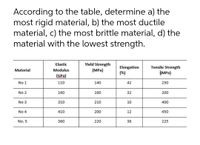
Elements Of Electromagnetics
7th Edition
ISBN: 9780190698614
Author: Sadiku, Matthew N. O.
Publisher: Oxford University Press
expand_more
expand_more
format_list_bulleted
Concept explainers
Question

Transcribed Image Text:According to the table, determine a) the
most rigid material, b) the most ductile
material, c) the most brittle material, d) the
material with the lowest strength.
Elastic
Yield Strength
Tensile Strength
Elongation
(%)
Material
Modulus
(MPa)
(MPA)
(GPa)
No 1
110
140
42
250
No 2
160
160
32
200
No 3
310
210
10
400
No 4
410
200
12
450
No. 5
360
220
36
225
Expert Solution
This question has been solved!
Explore an expertly crafted, step-by-step solution for a thorough understanding of key concepts.
Step by stepSolved in 2 steps with 2 images

Knowledge Booster
Learn more about
Need a deep-dive on the concept behind this application? Look no further. Learn more about this topic, mechanical-engineering and related others by exploring similar questions and additional content below.Similar questions
- MENG222 Strength of Materials Please give me abAbstract about f Experiment: Torsion Test All thank and appreciation ?? ?arrow_forwardGiven the following data for five different materials answer parts A B C D E & F with an explanationarrow_forwardThe engineering stress-strain curve below was obtained for a precipitation hardened Aluminum alloy. What is the approximate Yield Strength for this alloy in psi? Engineering Stress Based on Original Area (psi) 50,000 45,000 40,000 35,000 30,000 25,000 20,000 15,000 10,000 5,000 0 O 0.02 0.04 0.06 Aluminum 6061-T6 0.08 0.1 0.12 Engineering Strain (in/in) 0.14 X 0.16 0.18arrow_forward
- In the image demonstrated, what does E represent? A) Modulus of elasticity B) Olds modulus C) Proportional limit D) Elongationarrow_forwardIn the graph, the module of toughness can be shown to be represented by: A) The area associated with necking B) The rectangular area label yielding C) The triangular area in the elastic region D) The sum of the entire shaded area under the curvearrow_forwardPlease annotate the attached stress strain graph of 0.9% carbon steel to show the different phases. From the graph work out the following: 1) modulus of elasticity 2) tensile strength 3) the ductility in % elongation 4) yield strength at a strain offset of 0.002arrow_forward
- Please help with all, and desbribe how the table is used, thank you in advance! Will give thumbs uparrow_forwardWhich one(s) of the following about G, shear modulus of elasticity of a material are correct? select all which are correct. G is also called the modules of rigidity. G is related to the modulus of elasticity E and Poisson’s ratio . G is usually smaller than Young's modulus E for the same material. G is the ratio of shear stress to shear strain when the material's proportional limit in shear has not been exceeded.arrow_forwardDetermine the percentage of ductility of a metal alloy having the following tensile stress-strain diagram. 600 500E 400 500 300 400E 300 200 200 100 100 0.000 0.002 0.004 0.006 Strain 0.00 0.04 0.08 0.12 0.16 0.20 Strain EN Stress (MPa) Stress (MPa)arrow_forward
- Review Data taken from a stress-strain test for a ceramic are given in the table. The curve is linear between the origin and the first point. No elements selected a(ksi) 50 + 40 - 30 Figure 1 of 1 20 10 + o (ksi) € (in./in.) ex 10(in./in.) 0.5 1.0 1.5 2.0 2.5 33.2 0.0006 45.5 0.0010 Press (ENTER) to select this element. Press ESC) to return to the main menu. Press CTRL+Q) to quit the application. 49.4 0.0014 51.5 0.0018 53.4 0.0022arrow_forwardQ3 : Rank the magnitudes of the moduli of elasticity for the following hypothetical X, Y, and Z materials from the greatest to the least.The appropriate A, B, and n parameters for these three materials are tabulated below; they yield EN in units of electron volts and r in nanometers: Material A В n 2.5 2.0 x 10-5 8. Y 2.3 8.0 x 10-6 10.5 Z 3.0 1.5 x 10-5 9.arrow_forwardo (MPa) 900 800 700 600 500 400 300 200 100 0 0 0.01 0.02 0.03 0.04 0.05 0.06 0.07 0.08 0.09 Question 1 Which ONE of the following descriptions is TRUE for this material? Its yield stress is approximately 720 MPa. It is a brittle material. It is a ductile material. Its ductility as a percentage elongation is approximately 0.6%. Earrow_forward
arrow_back_ios
SEE MORE QUESTIONS
arrow_forward_ios
Recommended textbooks for you
 Elements Of ElectromagneticsMechanical EngineeringISBN:9780190698614Author:Sadiku, Matthew N. O.Publisher:Oxford University Press
Elements Of ElectromagneticsMechanical EngineeringISBN:9780190698614Author:Sadiku, Matthew N. O.Publisher:Oxford University Press Mechanics of Materials (10th Edition)Mechanical EngineeringISBN:9780134319650Author:Russell C. HibbelerPublisher:PEARSON
Mechanics of Materials (10th Edition)Mechanical EngineeringISBN:9780134319650Author:Russell C. HibbelerPublisher:PEARSON Thermodynamics: An Engineering ApproachMechanical EngineeringISBN:9781259822674Author:Yunus A. Cengel Dr., Michael A. BolesPublisher:McGraw-Hill Education
Thermodynamics: An Engineering ApproachMechanical EngineeringISBN:9781259822674Author:Yunus A. Cengel Dr., Michael A. BolesPublisher:McGraw-Hill Education Control Systems EngineeringMechanical EngineeringISBN:9781118170519Author:Norman S. NisePublisher:WILEY
Control Systems EngineeringMechanical EngineeringISBN:9781118170519Author:Norman S. NisePublisher:WILEY Mechanics of Materials (MindTap Course List)Mechanical EngineeringISBN:9781337093347Author:Barry J. Goodno, James M. GerePublisher:Cengage Learning
Mechanics of Materials (MindTap Course List)Mechanical EngineeringISBN:9781337093347Author:Barry J. Goodno, James M. GerePublisher:Cengage Learning Engineering Mechanics: StaticsMechanical EngineeringISBN:9781118807330Author:James L. Meriam, L. G. Kraige, J. N. BoltonPublisher:WILEY
Engineering Mechanics: StaticsMechanical EngineeringISBN:9781118807330Author:James L. Meriam, L. G. Kraige, J. N. BoltonPublisher:WILEY

Elements Of Electromagnetics
Mechanical Engineering
ISBN:9780190698614
Author:Sadiku, Matthew N. O.
Publisher:Oxford University Press

Mechanics of Materials (10th Edition)
Mechanical Engineering
ISBN:9780134319650
Author:Russell C. Hibbeler
Publisher:PEARSON

Thermodynamics: An Engineering Approach
Mechanical Engineering
ISBN:9781259822674
Author:Yunus A. Cengel Dr., Michael A. Boles
Publisher:McGraw-Hill Education

Control Systems Engineering
Mechanical Engineering
ISBN:9781118170519
Author:Norman S. Nise
Publisher:WILEY

Mechanics of Materials (MindTap Course List)
Mechanical Engineering
ISBN:9781337093347
Author:Barry J. Goodno, James M. Gere
Publisher:Cengage Learning

Engineering Mechanics: Statics
Mechanical Engineering
ISBN:9781118807330
Author:James L. Meriam, L. G. Kraige, J. N. Bolton
Publisher:WILEY